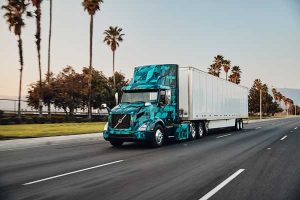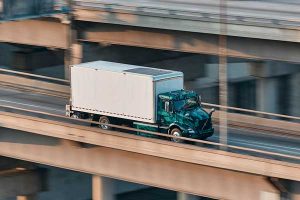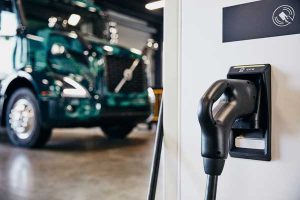Aiming at improving freight and warehouse efficiencies, Volvo Trucks has been pursuing the ‘LIGHTS’ project with much interest
Story By : Team CV

Teaming up with its fleet customers NFI and Dependable Highway Express to deploy its electric VNR trucks at their California port, Volvo Trucks has highlighted the progress it has achieved in its ambitious Low Impact Green Heavy Transport Solutions (LIGHTS) project by offering a first look at its Class 8 battery-electric project trucks at an exclusive event at TEC Equipment dealership in Fontana, California, recently. The Swedish CV major announced the ambitious project a little more than a year ago, and has been pursuing it with much interest. Aiming at improving freight and warehouse efficiencies, the project is about the demonstration of the ability of battery electric vehicles (EVs) to improve freight and warehouse efficiencies, reduce emissions and improve air quality.

Attracting a funding of more than USD 44 million from California Air Resources Board (CARB), according to Volvo Group President and CEO, Martin Lundstedt, Volvo LIGHTS highlights how various stakeholders have joined hands to achieve a common goal in the wake of climate change without bothering about who gets the credit. Claimed to point at how the CV industry will progress hereafter, and in-line with the need to tackle regulatory as well as market requirements, the Volvo LIGHTS project is slated to cross the USD 90 million cost-mark when its achieves what it has set out to achieve. Termed as an initiative that builds against a backdrop of 90 per cent of the Californians breathing unhealthy air during some time of the year, according to CARB board member Barbara Riordan, the LIGHTS project has come in include a total of 15 partners apart from those mentioned above over the course of time.
 With California’s South Coast Air Quality Management District (SCAQMD) and several transportation and electrical charging infrastructure participants making up the list of 15 stakeholders, the LIGHTS project, taking into consieration that 40 per cent of all imports pass through California’s ports, making it the logical launching point, has got its first five trucks running. Employing technologies that are currently being used in the North American Volvo VNR, the five 113-inch BBC electric VNR tractor models draw from its manufacturer’s experience in electric buses as well.
With California’s South Coast Air Quality Management District (SCAQMD) and several transportation and electrical charging infrastructure participants making up the list of 15 stakeholders, the LIGHTS project, taking into consieration that 40 per cent of all imports pass through California’s ports, making it the logical launching point, has got its first five trucks running. Employing technologies that are currently being used in the North American Volvo VNR, the five 113-inch BBC electric VNR tractor models draw from its manufacturer’s experience in electric buses as well.
They also gain from Volvo’s ability to sell 4,000 electrified Volvo buses since 2010. Creating mountains of data to ensure refining of technologies before commercial production could be initiatied on a higher scale, the five VNR electric trucks are working as an accelerator for a commercial solution, according to a Volvo source. Said Lars Stenqvist, Volvo Group chief technology officer that they are looking at the second phase of electrification. Stressing on the ease of adoption, he averred that the initiative would help Volvo to define the lifecycle and range of the truck’s batteries. Designed to go through two generations of batteries before entering production by the end of 2020, the LIGHTS project, it is clear, is targeting short- and regional-haul applications such as heavy urban distribution, drayage and other applications where electric trucks will have the greatest impact at their initial stages.
Tapping the speed of battery development, the five VNRs in operation around the Port of Los Angeles feature center-mounted dual electric motors with a two-speed gearbox. They pack what could be termed as a mostly conventional driveline behind the electric powertrain. Having four battery packs, each weighing about 1,150 pounds, the VNRs have a charging port each mounted on the driver’s side. The battery system is designed like a shelf, and enables the packs to be slid in and out for service. The radiator of the truck being fully functional and helping the system to be heated or cooled as per the need to support battery life, the LIGHTS project includes the deployment of neary 60 chargers with light- and heavy-duty capabilities.

The installation of the truck charging infrastructure was handled by Greenlots, a member of the Shell Group and a leader in Electric Vehicle (EV) charging and energy management solutions. It has put heavy-duty fleet charging stations amounting to four in number at warehouses across Southern California. Trillium, at the other end, is in the process of installing two 150kW chargers at a store in Anaheim, according to Volvo sources. It is part of the Love’s Travel Stop company. The two ABB 50 kW DC fast chargers at TEC Equipment’s Fontana dealership installed by Greenlots add to the charging infrastructure. Plans are being drawn up to install an additional 150 kW DC fast charger. With all the charging equipment for the project connected to Greenlots’ SKY EV Charging Network Software, which enables management of Volvo’s fleet and charging stations while balancing grid demand, the LIGHTS project is set to gain good traction.
Looking at how load demand on the electric grid could be balanced since it is turning out to be increasingly important in the wake of the rising number of EVs, the LIGHTS project, during its course of the journey over the last one year, saw the truck maker, TEC Equipment, and other partners work closely in the area of building the charging infrastructure. Looked upon as a project that will also help with rate analysis for customers to understand the costs associated with electrification, and to provide third-party check on vendor claims, the initiative is expected to offer an insight into leveraging solar energy apart from efficient battery storage management.
With TEC Equipment serving as a fully certified maintenance hub for the Volvo VNR Electric project trucks in the South Coast Air Basin, the LIGHTS project is expected to spring 15 battery electric VNR trucks as it progresses. TEC Equipment will look at leasing the trucks to interested customers for real-world trials. It would also offer a critical uptime support team for assistance with parts and service. With fewer mechanical parts and maintenance needs, the LIGHTS project is also expected to help clearly define the maintenance needs of such trucks within a duty-cycle. This is in view of a fundamental shift in business, and how it would affect the CV maker as well as its network. Anticipating a change in the nature of sales and service, the project is expected to provide an insight in the transition of CVs from conventional to electric. Training its product managers, Volvo Trucks is driving training and support programs within its dealer network. It is also refining parts inventory strategies as new learnings are had. Expected to unleash a huge change in job descriptions and responsibilities at the service level, the LIGHTS project has got Kenny Melancon, a diesel instructor with San Bernardino Valley College involved. In partnership with TEC Equipment and VTNA, he is crafting a curriculum for electric truck technicians. John Frala, a professor from Rio Hondo College is known to have also developed an electric vehicle curriculum in partnership with TEC Equipment.
 Driving the VNR
Driving the VNR
By Indian standards, the VNR amounts to a big tractor. It is a Class 8 truck of US standards after all. With a bonnet in front, the VNR looks big and powerful. It also offers a glimpse of how a truck of tomorrow is going to evolve. Climb inside, and the truck’s cockpit wraps around the driver. It is simple and straighforward. There’s minimal instrument and the gear shift lever is missing. The clutch pedal is also missing. There’s just two pedals thus. If the D, R and N buttons play the role of the missing gear lever, the parking brake is a prominent yellow knob situated below the instrument panel. Carrying out the same procedure that one would in an EV gets the big tractor going.
Engage the brake, engage the D button, release the parking brake and press the accelerator. The truck starts to move. The obvious difference is the height at which the driver is sitting. He or she is clearly many feet higher than in a typical EV. The big steering is a stark giveaway that this is an electric truck and not just any other EV. The pneumatic seat bounces up and down a little as the truck gathers momentum. Deriving from Volvo’s long running experience of building big semis for intrastate and interstate long-haul, the VNR electric is meant to do regional work. So it is more dock oriented for sure.
Throttle response is linear and devoid of any nasty surprises. Smooth and silent in its drive, the truck does not extend of any shift sensation. Sharing much of its frame, cab, and running gear with the regular VNR series, the electric truck is also devoid of the usual sounds of regeneration with the motors positioned far below. Account the slow steering and the higher seating, and the CV does not feel much different from that of the conventional VNR truck. An abundance of regenerative braking is delivered by the dual motor drivetrain when the need to cut down on speed arises. Braking action is strong and inspires confidence.
While regenerative braking is customisable in four steps via a steering column mounted stalk, the VNR electric is essentially a ‘mid-engine’ truck. Producing 536 hp peak power and 349 hp on a continuous basis, the truck has its motors spinning at up to 10,000 rpm. Compared to the redline of 2,000 rpm of the VNR diesel truck, this marks a big departure. The conventional looking nose housing a radiator to cool various parts of the system, the truck has its underhood area utilised for power electronics that manage 400-volt DC charging and supply the needs of the 600-volt electric motor and batteries. The CCS charge port is located on the driver’s side just below the cabin step.
Four battery packs hang in pairs off each side of the frame rails, with space for two more – if needed – behind the cab. Each pack is rated at 66 kWh, of which 50 kWh is usable. The exact range of the VNR electric is not being revealed by Volvo yet. The working range for the LIGHTS project, according to a Volvo source, is between 75 and 175 miles. A round trip to the port is about 125 miles, with an empty downhill run to the port and a loaded uphill run back to the warehouse district.



















